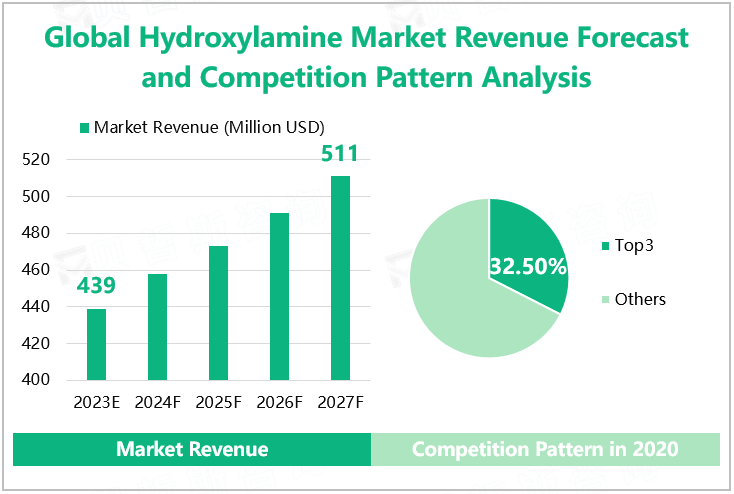Hydroxylamine, with the molecular formula NH2OH, has a melting point of 32.05℃ and a boiling point of 70℃ (1.33kPa) and is usually a white large or needle-shaped crystal. Hydroxylamine is a highly unstable organic substance that is highly hygroscopic and soluble in water. It can decompose in hot water and is slightly soluble in ether, benzene, carbon disulfide, and chloroform. Hydroxylamine is irritating to the respiratory system, skin, eyes, and mucous membranes, and is harmful if swallowed, making it a potential mutagen.
The Synthesis of Caprolactone Amine is the Largest Downstream Application Market.
According to different sources (preparation methods), hydroxylamines can usually be divided into two categories: hydroxylamine hydrochloride and hydroxylamine sulfate. Hydroxylamine hydrochloride is commonly used as a reducing agent and imaging agent for color films. It is used in organic synthesis to synthesize oximes, anticancer drugs, and sulfonamide drugs; In the synthetic rubber industry, it is used as a non-coloring short-term stopping agent and also as an analytical reagent for the detection of aldehydes and ketones organic compounds, as well as for the microanalysis of sulfonic acids. It is also used as a depolarizer in electrical analysis. Hydroxylamine sulfate is commonly used as a reducing agent, developer, and rubber vulcanizing agent. It is an important raw material for synthesizing caprolactam and an intermediate in medicine and pesticides. It is used to produce a series of isoxazole derivatives, sulfonamide drugs, and vitamins B6 and B12. In addition, its oxime or hydroxamic acid derivatives can be used in the production of insecticides, fungicides, and herbicides for pesticides, as well as in the refinement of polymer synthesis raw materials and compounds, polymerization catalysts, and reagents.
According to our research data, the global production of hydroxylamine hydrochloride and hydroxylamine sulfate is expected to reach 85000 tons and 93600 tons respectively in 2023, accounting for 47.59% and 52.41%, respectively. From the perspective of downstream application patterns, the synthesis field of caprolactone amine is the largest downstream application market. Data shows that the global consumption of hydroxylamine in the field of caprolactone synthesis is expected to reach 68100 tons in 2023, accounting for an estimated 37.94% of the total consumption.
Global Hydroxylamine Production and Consumption Forecast by Type and Application in 2023
|
Segmented by Type |
Production (Tons) |
Share |
|
Hydroxylamine Sulfate |
93600 |
52.41% |
|
Hydroxylamine Hydrochloride |
85000 |
47.59% |
|
Segmented by Application |
Consumption (Tons) |
Share |
|
Synthesis of Caprolactone Amine |
68100 |
37.94% |
|
Pharma Industry |
37000 |
20.61% |
|
Agrochemicals |
32600 |
18.16% |
|
Used as an Additives |
26600 |
14.82% |
|
Others |
15200 |
8.47% |
Source: www.globalmarketmonitor.com
The Total Market Revenue is Expected to Reach$439 Million in 2023.
Based on our research data, the total revenue of the global hydroxylamine market is expected to reach $439 million in 2023 and may increase to $511 million by 2027. In terms of market competition pattern, research shows that the concentration of the global hydroxylamine market is relatively low. Data shows that in 2020, the sales volume of hydroxylamine in the industry's top 3 enterprises totaled 46700 tons, with a total market revenue of 122.28 million and a total revenue share of 32.50%. The top 3 companies were BASF, Shandong Jinan Chemical Co. Ltd., and Ube Industries, Ltd. Their revenue in the hydroxylamine market accounted for 20.70%, 6.89%, and 4.92% of the global market in 2020, respectively.

Source: www.globalmarketmonitor.com
For more information, please click:《China Hydroxylamine Industry Market Research Report 2023-2029》.We provide more professional and intelligent market reports to complement your business decisions.